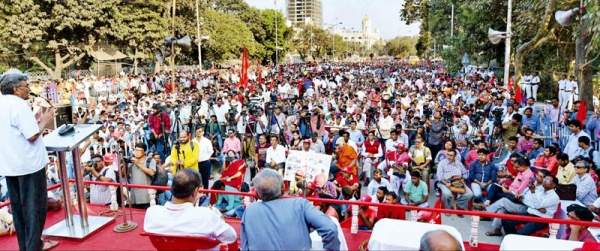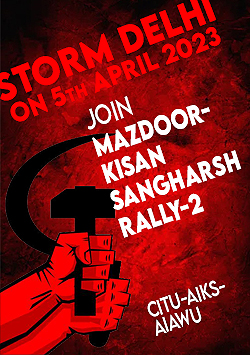Strike was participated by workers of all sectors including organised sector, both public and private including multinational, government and quasi government; scheme workers, unorganised sector workers across the country.
The strike was supported by wide sections of the people. AIKS and other Kisan organisations, independently and jointly, and with agricultural workers unions organised solidarity actions and, along with the workers and other toiling sections, resorted to Rail Roko and Rasta Roko in several parts of the country. They also gave call of simultaneous Gram Bandh (rural strike). Women, youths and students in large number, under the banner of their respective organisations, also joined in pre-strike campaigns; and rallies and demonstrations on strike days. Striking workers, their families and dependents, and those who were in solidarity actions and supported the strike across the country constituted almost half of India’s total 133.92 crore population.
8-9 January 2019 strike was for 10 demands, which are being pursued unitedly by the trade unions since 2009. 2 more demands – no change in labour laws; and no FDI in defence, railways and insurance - were added before 2015 strike to resist Modi government’s attacks in these areas. This strike was also in support of peasants

Despite imposition of ESMA in Delhi and threats and intimidation of the employees, large scale arrests and state-sponsored violence in West Bengal, Tripura and in some other states the strike became historic. With people’s participation workers strike created Bandh like situation in several states like in Kerala, Assam and other north eastern states, Odisha and in several districts of Karnataka.
Brihanmumbai Electric Supply & Transport Undertaking(BEST) has resorted to penal action on the striking workers by banning the strike. A day before the strike the Authority went to the Industrial Court which declared the strike as illegal under Maharashtra Essential Services Act. The Senior Personnel Manager (Welfare) has ordered the striking workers to evict tenements they have been allotted to stay although the Court order had not directed to such action. CITU has protested to this action in a letter to the Chief Minister of Maharashtra.
Road transport was paralysed in Kerala, Karnataka, Maharashtra, Bihar, Haryana, Punjab, Uttarakhand, in 22 districts of Madhya Pradesh; interstate buses service in Jammu and Kashmir was affected.
In West Bengal, despite TMC terror road transport, both passenger and goods, remained severely affected. Several industries including jute and engineering industries remained closed. In Tripura despite BJP government’s attacks strike was more than 70% in transport and in shops and establishments. In the tribal areas of Tripura there was total bandh.
The strike was highly visible in the industrial areas of NCR Delhi, 24 Paraganas, Hooghly
and Howrah districts of West Bengal, in the oil refineries across Assam, in Pune, Nashik and Aurangabad industrial areas in Maharashtra, in the industrial areas in Bengaluru, Mysore etc in Karnataka, in Ludhiana in Punjab, in the Bokaro, Ranchi, Adityapur Gamharia industrial areas in Jharkhand, in the engineering clusters in Baroda, Surat, Bhavnagar, Rajkot, Junagarh and Ahmedabad in Gujarat and the industrial clusters in Hyderabad and surrounding districts in Telengana etc. It was total in multinational companies like BOSCH, CEAT, Crompton, Samsonite in Maharashtra and in all the units of Volvo, Toyota and its subsidiaries in Karnataka. All over the country, workers struck work and marched in processions in thousands and held rallies and public meetings.
Strike was near total in the coal industry affecting production and dispatch. It was almost total in Vizag and Salem steel plants and also in all the iron-ore and coal mines under steel industry, around 50% in Rourkela steel Plant and Bhadravati, while partial in others steel plants. The participation of contract workers in most of the PSUs was total.
Electricity employees in many states joined the strike en masse. Though the railway employees did not join the strike, in several places they extended support. The railway contract workers and goods shed workers, safai karmacharis joined the strike in several states.
The tea gardens in Assam, West Bengal and Kerala were totally closed due to the strike. Unorganised workers, including beedi workers, construction workers, loading and unloading workers, shop employees, private hospital employees etc joined the strike in a big way in many states and organised Road–roko and Rail-roko in many places paralysing the normal traffic.
Scheme workers including anganwadi employees, ASHAs, midday meal workers and others joined the strike en masse across the country and participated in demonstrations.
Strike was total in insurance and BSNL and near total except in a few banks in the banking sectors. Central government employees participated in a massive manner in the strike, which was total among the postal and income tax departments. Atomic energy employees participated in a big way. It was total among medical representatives all over the country. In several states state government offices wore a deserted look due to the strike. In Tripura, though teachers were compelled to attend schools, there were no students. In several states including West Bengal, Assam, Jharkhand etc, police resorted to arrests. Thousands of CITU activists and Left party leaders were arrested. In Nimrana industrial area in Alwar district of Rajasthan, police resorted to lathi charge, teargas shelling and filing false cases against trade union activists.



